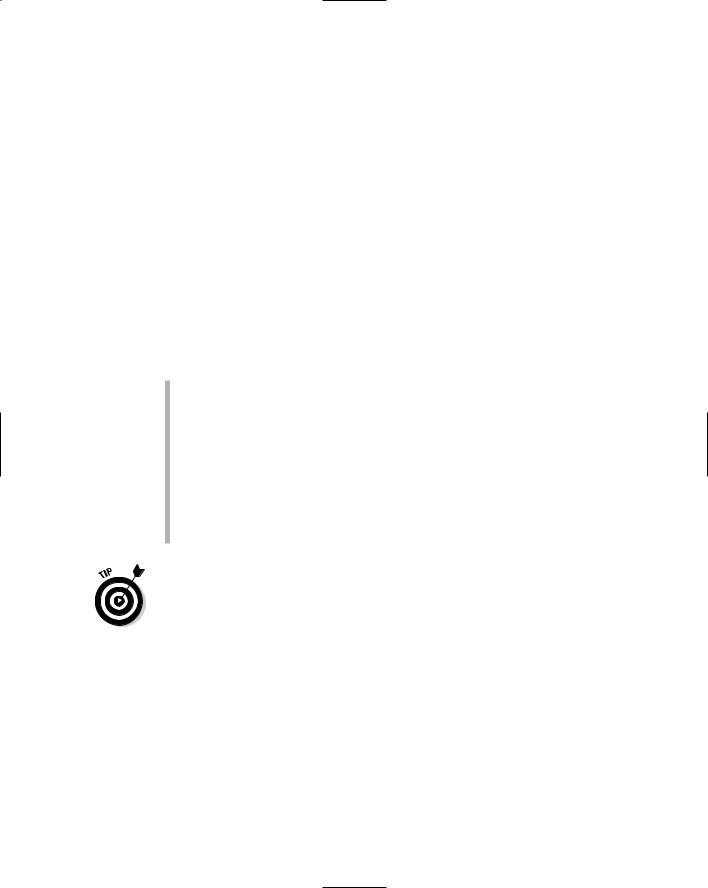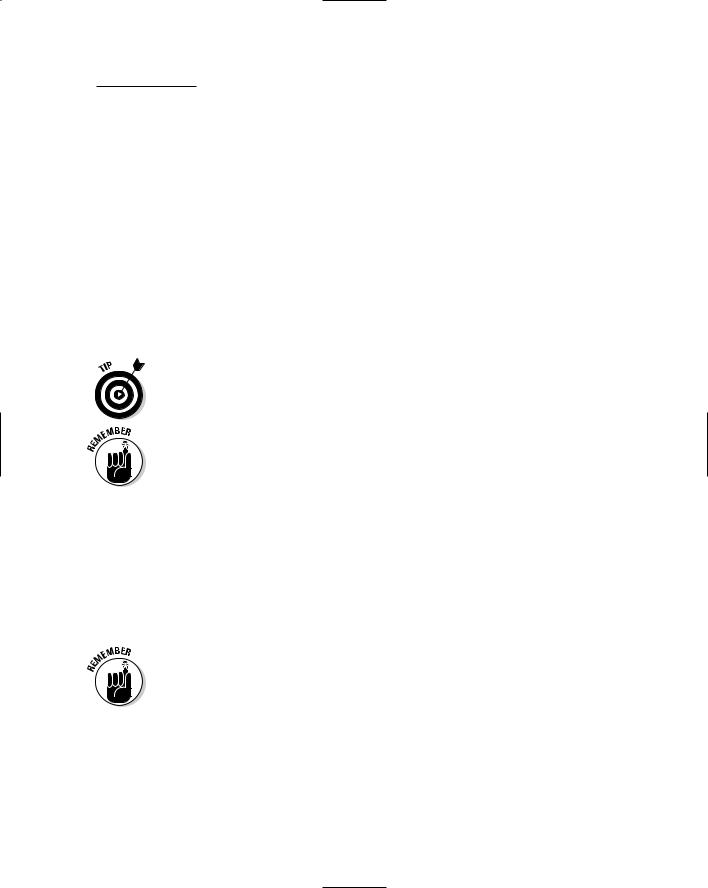
Russian For Dummies
.pdf
44 |
Part I: Getting Started |
Imagine that somebody asks you if you saw Nina today: Ty vidyel Ninu? (tih vee-deel nee-noo; Did you see Nina?) You didn’t. In preparing to answer this question, you may decide not to use the word “Nina” again but to replace it with the pronoun “her.” Because “Nina” is a direct object, you have to use the accusative case in translating the word “her.” Using Table 2-6, you discover that accusative case of ona (ah-nah; she) is yeyo (ee-yo; her). You respond Ya yeyo nye vidyel. (ya ee-yo nee vee-deel; I didn’t see her.)
You add the letter n to the beginning of pronouns whose first letter is a vowel when the pronoun is used right after a preposition. Refer to Table 2-6 for the pronouns that do this.
Surveying possessive pronouns
Possessive pronouns indicate ownership or possession. Words like my, mine, your, yours, his, her, hers, our, ours, their, and theirs are English possessive pronouns. In Russian, a possessive pronoun must always agree in number, gender, and case with the noun it’s referring to. Table 2-7 shows you how to form the possessive pronouns in the nominative case, which is by far the case you’ll use most.
Table 2-7 Forming Possessive Pronouns in the Nominative Case
English |
When It |
When It |
When It |
When It |
Possessive |
Modifies a |
Modifies a |
Modifies a |
Modifies a |
Pronoun |
Masculine |
Feminine |
Neuter Noun |
Plural Noun |
|
Noun |
Noun |
|
(All Genders) |
My/mine |
moj (mohy) |
moya (mah-ya) |
moyo (mah-yo) |
moi (mah-ee) |
|
|
|
|
|
Your/yours |
tvoj (tvohy) |
tvoya (tvah-ya) |
tvoyo (tvah-yo) |
tvoi (tvah-ee) |
(informal |
|
|
|
|
singular) |
|
|
|
|
|
|
|
|
|
His |
yego (ee-voh) |
yego (ee-voh) |
yego (ee-voh) |
yego (ee-voh) |
|
|
|
|
|
Her/hers |
yeyo (ee-yo) |
yeyo (ee-yo) |
yeyo (ee-yo) |
yeyo (ee-yo) |
|
|
|
|
|
Our/ours |
nash (nahsh) |
nasha (nah-shuh) |
nashye |
nashi (nah-shih) |
|
|
|
(nah-sheh) |
|
|
|
|
|
|
Your/yours |
vash (vahsh) |
vasha (vah-shuh) |
vashye |
vashi (vah-shih) |
(formal |
|
|
(vah-sheh) |
|
singular |
|
|
|
|
and plural) |
|
|
|
|
|
|
|
|
|
Their/theirs |
ikh (eekh) |
ikh (eekh) |
ikh (eekh) |
ikh (eekh) |
|
|
|
|
|

Chapter 2: The Nitty Gritty: Basic Russian Grammar and Numbers |
45 |
Say you’re getting ready to go out on the town and you notice you lost your favorite shirt. You want to say, “Where’s my shirt?” Because rubashka (roo- bahsh-kuh; shirt) ends in -a, it’s a feminine noun. (For information on determining a noun’s gender, see “Which one is it? How to tell the gender of a Russian noun” earlier in this chapter.) Because my modifies the feminine noun rubashka, it’s written moya (mah-ya; my) according to Table 2-7. The phrase you want is Gdye moya rubashka? (gdye mah-ya roo-bahsh-kuh; Where’s my shirt?)
Now say you can’t find your tie either. You want to ask, Gdye moj galstuk? (gdye mohy gahl-stook; Where’s my tie?) Notice how my is now written moj (moy), because in this sentence, it modifies the masculine noun galstuk.
A possessive pronoun changes its endings in all the cases. Its declension is totally dependent on the way the noun it is attached to declines. So the phrase moya kniga (mah-ya knee-guh; my book) declines differently from the phrase moj tyelyefon (moy tee-lee-fohn; my telephone) for one simple reason: Kniga is a feminine noun and tyelyefon is a masculine noun.
Investigating interrogative pronouns
Interrogative pronouns are question words like who, whose, and which. “Who” in Russian is kto (ktoh), and you’re likely to hear or use this word in phrases like
Kto eto? (ktoh eh-tuh; Who is that?)
Kto on? (ktoh ohn; Who is he?)
Kto vy? (ktoh vih; Who are you?)
Kto changes its form depending on the case it’s in. It becomes kogo (kah-voh; whom) in the genitive case, kogo (kah-voh; whom) in the accusative case, kom (kohm; whom) in the dative case, kyem (kyem; whom) in the instrumental case, and kom (kohm; whom) in the prepositional case. But you hear and use the basic nominative case form kto in most situations. And just as in English, you use kto no matter what the gender of the noun is.
“Whose” in Russian is chyej (chyey), and “which” is kakoj (kuh-kohy). Chyej and kakoj change their endings depending on the gender, number, and case of the noun they modify. For now, you just need to know the nominative case endings in Table 2-8.

46 |
Part I: Getting Started |
|
|
|
|
|
|
|
|
|
|
|
|||
|
|
|
|
|
|||
|
|
Table 2-8 |
Nominative Case Endings for Chyej |
||||
|
|
|
|
|
(Whose) and Kakoj (Which) |
|
|
|
|
Interrogative |
When It |
When It |
When It |
When It |
|
|
|
Pronoun |
Modifies a |
Modifies a |
Modifies a |
Modifies a |
|
|
|
|
|
Masculine |
Feminine |
Neuter Noun |
Plural Noun |
|
|
|
|
Noun |
Noun |
|
|
|
|
chyej (chyey; |
chyej (chyey) |
ch’ya (ch’ya) |
ch’yo (ch’yo) |
ch’i (ch’yee) |
|
|
|
whose) |
|
|
|
|
|
|
|
|
|
|
|
|
|
|
|
kakoj (kuh- |
kakoj |
kakaya (kuh- |
kakoye (kuh- |
kakiye (kuh- |
|
|
|
kohy; which) |
(kuh-kohy) |
kah-ye) |
koh-ee) |
kee-ee) |
|
|
|
|
|
|
|
|
|
Here are examples of some phrases you may hear or say using the interrogative pronouns chyej and kakoj:
Chyej eto dom? (chyey eh-tuh dohm; Whose house is that?) Dom (house) is masculine, so you use chyej.
Ch’ya eta kniga? (ch’ya eh-tuh knee-guh; Whose book is that?) Kniga (book) is feminine, so you use ch’ya.
Kakoj magazin ty pryedpochitayesh’? (kuh-kohy muh-guh-zeen tih preed-puh-chee-tah-eesh’; Which store do you prefer?) Magazin (store) is masculine, so you use kakoj.
Kakoye blyudo ty pryedpochitayesh’? (kuh-koh-ee blyu-duh tih preed- puh-chee-tah-eesh’; Which dish do you prefer?) Blyudo (dish) is neuter, so you use kakoye.
The question words kogda (kahg-dah; when), gdye (gdye; where), and chto (shtoh; what) are also sometimes used as interrogative pronouns. The good news is that kogda and gdye never change their form. Chto changes its form for all cases.
Decorating Your Speech with Adjectives
Adjectives spice up your speech. An adjective is a word that describes, or modifies, a noun or a pronoun, like good, nice, difficult, or hard. In the following sections, you discover how to use adjectives, how to change their endings for different cases, and what to do about the articles “the” and “a.”

Chapter 2: The Nitty Gritty: Basic Russian Grammar and Numbers |
47 |
Always consenting: Adjective-noun agreement
A Russian adjective is like a jealous lover. It can’t live without the noun or the pronoun it describes. In English, an adjective never changes its form no matter what word it modifies or where it’s used in a sentence, but a Russian adjective always agrees with the noun or pronoun it modifies in gender, number, and case. Table 2-9 shows how to change adjective endings in the nominative case, which is the case you’re likely to see and use the most.
Table 2-9 |
Adjective Formation in the Nominative Case |
|
If an Adjective |
The Adjective |
Examples |
Modifies |
Takes the |
|
|
Ending |
|
A masculine |
-oj//ij/yj |
bol’shoj myach (bahl’-shohy myach; big ball) |
noun/pronoun |
|
sinij pidzhak (see-neey peed-zhahk; |
|
|
blue jacket) |
|
|
krasivyj mal’chik (kruh-see-vihy mahl’-cheek; |
|
|
beautiful boy) |
A feminine |
-aya/yaya |
bol’shaya kniga (bahl’-shah-ye knee-guh; big |
noun/pronoun |
|
book) |
|
|
sinyaya shuba (see-nee-ye shoo-buh; blue fur |
|
|
coat) |
|
|
krasivaya rubashka (krah-see-vuh-ye roo- |
|
|
bahsh-kuh; beautiful shirt) |
|
|
|
A neuter noun |
-oye/yeye |
bol’shoye zhivotnoye (bahl’-shoh-ee zhih-voht- |
|
|
nuh-ee; big animal) |
|
|
sinyeye okno (see-nee-ee ahk-noh; blue |
|
|
window) |
|
|
krasivoye myesto (krah-see-vuh-ee myes-tuh; |
|
|
beautiful place) |
|
|
|
A plural noun |
-yye/iye |
bol’shyye zhivotnyye (bahl’-shih-ee zhee-voht- |
|
|
nih-ee; big animals) |
|
|
siniye okna (see-nee-ee ohk-nuh; blue |
windows)
krasivyye myesta (krah-see-vih-ee mees-tah; beautiful places)

48 |
Part I: Getting Started |
Dictionaries list adjectives in their singular and masculine form (the first row in Table 2-9). The trick is correctly selecting the ending for the adjectives’ feminine, neuter, and plural forms; dictionaries don’t provide these forms because dictionary compilers assume that you know how to do it. You’re not on your own; we’re going to provide you with some general rules:
If an adjective in its masculine form ends in -oj/-yj:
•Replace the original ending with -aya to make it feminine
•Replace the original ending with -oye to make it neuter
•Replace the original ending with -yye to make it plural
If an adjective in its masculine form ends in -ij:
•Replace the original ending with -yaya to make it feminine
•Replace its original ending with -yeye to make it neuter
•Replace the original ending with -iye to make it plural
Now put the rule to work. Take the word poslyednij (pahs-lyed-neey; last). As you see, in its dictionary (singular and masculine) form, the adjective has the ending -ij. How are we going to change the ending of this adjective to say “the last word” in Russian?
Figure out the gender of the word “word” (sorry!). Its Russian equivalent is slovo (sloh-vuh; word). The ending in this word is -o. The ending -o in a noun indicates neuter gender (refer to Table 2-1). What ending does poslyednij take when it’s used with a neuter noun? Yes, the ending is -yeye. So “the last word” in Russian is poslyednyeye slovo (pahs-lyed-nee-ee sloh-vuh).
A lot in common: Putting adjectives into other cases
Table 2-10 shows how to change adjective endings for all the cases other than nominative. (Work with Table 2-9 to figure out which particular ending to use in each case.) Notice how masculine and neuter nouns take the same endings in the genitive, dative, instrumental, and prepositional cases. The feminine endings are the same for all cases except accusative. And the plural genitive and plural prepositional endings are the same.

Chapter 2: The Nitty Gritty: Basic Russian Grammar and Numbers |
49 |
Table 2-10 Adjective Declension in the Genitive, Accusative, Instrumental, and Prepositional Cases
If the |
To Form |
To Form |
To Form |
To Form |
To Form |
Adjective |
Genitive |
Accusative |
Dative |
Instrumental |
Prepositional |
Modifies |
|
|
|
|
|
A masculine |
Replace |
If the noun |
Replace |
Replace -oj/ |
Replace |
noun |
-oj/ij/yj |
is a living |
-oj/ij/yj |
ij/yj with |
-oj/ij/yj with |
|
with -ogo/ |
being, it |
with -omu/ |
-ym/im/ym |
-om/im/om |
|
yego/ogo |
looks just |
yemu/ |
|
|
|
|
like the |
omu |
|
|
|
|
genitive; |
|
|
|
|
|
otherwise, |
|
|
|
|
|
it looks just |
|
|
|
|
|
like the |
|
|
|
|
|
nominative |
|
|
|
|
|
(see |
|
|
|
|
|
Table 2-9) |
|
|
|
|
|
|
|
|
|
A feminine |
Replace |
Replace |
Replace |
Replace |
Replace |
noun |
-aya/yaya |
-aya/yaya |
-aya/yaya |
-aya/yaya |
-aya/yaya |
|
with -oj/ |
with -uyu/ |
with -oj/ |
with -oj/ |
with -oj/yej/oj |
|
yej/oj |
yuyu/uyu |
yej/oj |
yej/oj |
|
|
|
|
|
|
|
A neuter |
Replace |
It looks just |
Replace |
Replace |
Replace |
noun |
-oye/yeye |
like the |
-oj/ij/yj |
-oj/ij/yj with |
-oj/ij/yj with |
|
with -ogo/ |
nominative |
with |
-ym/im/ym |
-om/im/om |
|
yego |
(see |
-omu/ |
|
|
|
|
Table 2-9) |
yemu/omu |
|
|
|
|
|
|
|
|
A plural |
Replace |
If the noun |
Replace |
Replace |
Replace |
noun |
-yye/iye |
is a living |
-yye/iye |
-yye/iye with |
-yye/iye with |
|
with |
being it looks |
with |
-ymi/imi |
-ykh/ikh/ |
|
-ykh/ikh |
just like the |
-ym/im |
|
|
|
|
genitive; |
|
|
|
|
|
otherwise |
|
|
|
|
|
it looks just |
|
|
|
|
|
like the |
|
|
|
|
|
nominative |
|
|
|
|
|
(see |
|
|
|
|
|
Table 2-9) |
|
|
|

50 |
Part I: Getting Started |
Nowhere to be found: The lack of articles in Russian
The English words the, a, and an are called articles. You use articles all the time in English, but these words don’t exist in Russian, so you don’t need to worry about how to say them. When you want to say the, a, or an, all you have to do is say the noun you mean. “The store” and “a store” in Russian are simply magazin (muh-guh-zeen; Literally: store). “The girl” and “a girl” are simply dyevushka (dyeh-voosh-kuh; Literally: girl).
Adding Action with Verbs
If nouns and pronouns are the building blocks and adjectives the flavoring in a Russian sentence, then the verb is the engine. Without the verb, you can’t express a complete thought. A Russian verb carries loads of important information. It can reveal whether an action was completed or resulted in something and whether the action occurs on a regular basis or is a one-time event. Russian verbs also reveal the number (and, in the past tense, the gender) of the person or thing performing the action.
In the following sections, we show you how to spot the infinitive of a verb, and how to form verbs in the past, present, and future tenses. We also tell you about a basic but unusual verb often used in Russian.
Spotting infinitives
Spotting Russian infinitives is easy, because they usually end in a -t’ as in chitat’ (chee-taht’; to read), govorit’ (guh-vah-reet’; to speak), and vidyet’ (veed-yet’; to see).
Some Russian verbs (which are usually irregular) take the infinitive endings -ti as in idti (ee-tee; to walk) and -ch’ as in moch’ (mohch’; to be able to). For a list of common irregular verbs, see Appendix A.
In a Russian dictionary, as in any language dictionary, verbs are always listed in their infinitive form. Why? Well, imagine a dictionary that lists all verb forms. It probably would be a dictionary the size of the Kremlin.

Chapter 2: The Nitty Gritty: Basic Russian Grammar and Numbers |
51 |
Living in the present tense
Russian verbs have only one present tense. Like English verbs, Russian verbs conjugate (change their form) so that they always agree in person and number with the subject of the sentence. To conjugate most Russian verbs in the present tense, you drop the infinitive ending -t’ and replace it with one of the six endings in Table 2-11.
Table 2-11 |
Forming the Present Tense of Verbs |
|
Subject of Sentence |
Drop the Infinitive Verb |
Example |
|
Ending (-t’) and Replace |
|
|
It With |
|
ya (ya; I) |
-yu |
ya rabotayu (ya ruh-boh-tuh- |
|
|
yu; I work/am working) |
|
|
|
ty (tih; you; informal |
-yesh’ |
ty rabotayesh’ (tih ruh-boh- |
singular) |
|
tuh-eesh’; You work/are |
|
|
working) |
on/ona/ono (ohn/ah- |
-yet |
on rabotayet (ohn ruh-boh- |
nah/ah-noh; he/she/it) |
|
tuh-eet; He works/is working) |
|
|
|
my (mih; we) |
-yem |
my rabotayem (mih ruh-boh- |
|
|
tuh-eem; We work/are |
|
|
working) |
vy (vih; you; formal |
-yetye |
vy rabotayetye (vih ruh-boh- |
singular and plural) |
|
tuh-ee-tee; You work/are |
|
|
working) |
|
|
|
oni (ah-nee; they) |
-yut |
oni rabotayut (ah-nee ruh- |
|
|
boh-tuh-yut; They work/are |
|
|
working) |
|
|
|
The present tense in Russian corresponds to both the present simple and present continuous tenses in English; in other words, it denotes both the general action in the present tense (such as “I work”) and the action taking place at the moment of speaking (such as “I am working”).
Verbs that conjugate as -yu, -yesh’, -yet, -yem, -yetye, and -yut are called firstconjugation verbs. The term in itself implies that second-conjugation verbs exist; they conjugate as -yu, -ish’, -it, -im, -itye, and -yat. So how do you know whether the verb is the first or second conjugation? Easy: Dictionaries always indicate this situation. In addition, a lot of verbs conjugate — how should we

52 |
Part I: Getting Started |
put it? — in whatever way they want to conjugate (in other words, in a completely unpredictable fashion!). How do you deal with such verbs? Always check with the dictionary; dictionaries always indicate something peculiar in verb conjugations. However, they don’t list all the forms but only three of them, usually the ya (I), ty (you; informal singular), and oni (they) forms with the hope that you can figure out the rest of the forms.
We alert you to regular verbs that follow the second-conjugation pattern and irregular verbs with conjugation peculiarities throughout this book.
Talking about the past tense
In the following sections, we show you how to form the past tense of Russian verbs and explain the differences between imperfective and perfective verbs.
Keep it simple: Forming the past tense
To form the past tense of a Russian verb, all you need to do is drop the infinitive ending -t’ and replace it with one of four endings in Table 2-12.
Table 2-12 |
Forming the Past Tense of Verbs |
|
If the Subject of |
Drop the Infinitive Ending |
Example |
the Sentence Is |
-t’ and Replace It With |
|
Masculine singular |
-l |
on rabotal (ohn ruh-boh-tuhl; |
|
|
He worked) |
|
|
|
Feminine singular |
-la |
ona rabotala (ah-nah ruh- |
|
|
boh-tuh-luh; She worked) |
|
|
|
Neuter singular |
-lo |
ono rabotalo (ah-noh ruh- |
|
|
boh-tuh-luh; It worked) |
|
|
|
Plural |
-li |
oni rabotali (ah-nee ruh-boh- |
|
|
tuh-lee; They worked) |
|
|
|
Perfective or imperfective? That is the question
English expresses past events either through the past simple tense (I ate yesterday) or the present perfect tense (I have eaten already). While I ate yesterday simply states a fact, I have eaten already emphasizes the result of the action. Russian verbs do something similar by using what’s called verbal aspect. Two aspects exist in Russian: perfective and imperfective.

Chapter 2: The Nitty Gritty: Basic Russian Grammar and Numbers |
53 |
Up to this point, we’ve been withholding some very essential information from you: Every English verb in the English-Russian dictionary is represented by two Russian verbs, its imperfective equivalent and a perfective counterpart. Usually, the imperfective is listed first in the aspectual pair, like in this example:
To read — chitat’ (chee-taht’)/prochitat’ (pruh-chee-taht’)
In this example, chitat’ is the imperfective infinitive, and prochitat’ is the perfective infinitive. You form the perfective aspect by adding the prefix pro- to the imperfective infinitive. Don’t assume, however, that you add pro- to every Russian imperfective verb to find its perfective aspect. It’s not that simple. Sometimes the perfective aspect of a verb looks quite different from the imperfective aspect, as in the case of the verb “to look/to glance”: glyadyet’ (glee-dyet’) and glyanut’ (glee-noot’). Glyadyet’ is the imperfective infinitive and glyanut’ is the perfective infinitive.
The formation of the perfective infinitive is as unpredictable as the rest of Russian grammar. Our advice: When you memorize a new Russian verb, memorize both its imperfective and perfective aspects.
To emphasize the fact of an action in the past or to express habitual or repeated action in the past, Russian uses the imperfective aspect form of the verb. To emphasize the result or completion of the action, Russian uses the perfective aspect of the verb. You also use the perfective aspect of a verb if you want to emphasize a single, momentary event that took place in the past, such as breaking a plate.
If you tell someone Ya pisal ryezyumye tsyelyj dyen’ (ya pee-sahl ree-zyu- meh tseh -lihy dyen’; I was writing my resume all day), you use the past tense imperfective form of the verb pisat’, because your emphasis is on the fact of writing, not on the completion of the task. If you finished writing your resume, you use the past tense perfective form of the verb, because your emphasis is on the completion of the action: Ya napisal ryesyumye. (ya nuh-pee-sahl ree- zyu-mye; I have written my resume.)
Knowing which of the two aspects to select is important only when you speak about the past or the future (see the next section). Russian doesn’t have aspects in the present tense. In other words, in describing present tense events, you can use only the imperfective form of the verb. Don’t even think about using perfective form in the present tense!
